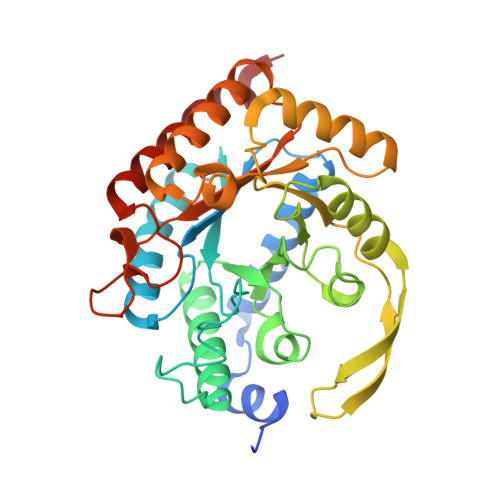Structural Analysis of Substrate-Mimicking Inhibitors in Complex with Neisseria Meningitidis 3-Deoxy-D-Arabino-Heptulosonate 7-Phosphate Synthase - the Importance of Accommodating the Active Site Water.
Heyes, L.C., Reichau, S., Cross, P.J., Jameson, G.B., Parker, E.J.(2014) Bioorg Chem 57: 242
- PubMed: 25245459
- DOI: https://doi.org/10.1016/j.bioorg.2014.08.003
- Primary Citation of Related Structures:
4UMA, 4UMB, 4UMC - PubMed Abstract:
3-Deoxy-d-arabino-heptulosonate 7-phosphate synthase (DAH7PS) catalyses the first committed step of the shikimate pathway, which produces the aromatic amino acids as well as many other aromatic metabolites. DAH7PS catalyses an aldol-like reaction between phosphoenolpyruvate and erythrose 4-phosphate. Three phosphoenolpyruvate mimics, (R)-phospholactate, (S)-phospholactate and vinyl phosphonate [(E)-2-methyl-3-phosphonoacrylate], were found to competitively inhibit DAH7PS from Neisseria meningitidis, which is the pathogen responsible for bacterial meningitis. The most potent inhibitor was the vinyl phosphonate with a Ki value of 3.9±0.4μM. We report for the first time crystal structures of these compounds bound in the active site of a DAH7PS enzyme which reveals that the inhibitors bind to the active site of the enzyme in binding modes that mimic those of the predicted oxocarbenium and tetrahedral intermediates of the enzyme-catalysed reaction. Furthermore, the inhibitors accommodate the binding of a key active site water molecule. Together, these observations provide strong evidence that this active site water participates directly in the DAH7PS reaction, enabling the facial selectivity of the enzyme-catalysed reaction sequence to be delineated.
Organizational Affiliation:
Biomolecular Interaction Centre and Department of Chemistry, University of Canterbury, Christchurch, New Zealand.

















